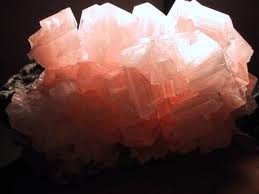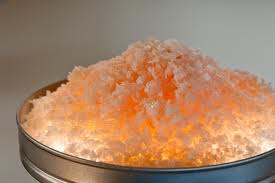Do You Know What's in the Salt You Eat?
Salt, or sodium chloride, is one of the most commonly used minerals in the world, and is integral to life itself. Consisting of two elements, sodium (Na) and chlorine (Cl), both elements volatile on their own, sodium chloride (NaCl) forms the mineral halite – what we call common salt.
Sodium chloride crystals have a cubic form. The size of the crystals depends on its intended use. Rock salt is often used for deicing roads, and fine salt as table salt.
|
Halite results from the drying up of bodies of water, sometimes called salt flats. It can also be found in the form of underground beds, salt mines, salt domes, and even salt glaciers. The Bonneville Salt Flats in Utah, famous for the Bonneville Speedway for land speed records, are the remnants of a lake. Some salt flats are protected, such as the fragile Badwater Basin in Death Valley, California. Surface salt flats can actually be seen from space. |
 |
Sea water is one of the best sources of salt and is an inexhaustible supply.
A salt of many colors
We are all familiar with table salt; white in color, it is the most commonly used salt. But salt comes naturally in other colors.
 |
Salt harvested from the Himalayas derives its pink color from additional minerals of copper, iron, potassium, calcium, and magnesium. Gray salt comes from trace minerals. Another gray salt may be a gourmet smoked salt. A dark pinkish-gray colored salt, usually referred to as “black salt” may come from several sources. The dark color of a Hawaiian salt comes from traces of charcoal and lava. |
|
Another salt has a more peachy color, due to the carotene from a type of salt-tolerant algae. Iron oxide from volcanic clay gives Hawaiian alaea salt its reddish-pink color. Sea salt is usually a less processed salt, retaining trace minerals. Sea salt also comes in a variety of colors; white, pink, black, gray, or a combination, depending on the minerals it contains. |
|
Iodine is normally added to common processed table salt. With a healthy diet, iodine can be obtained without consuming iodized salt. Some people notice a slightly metallic taste with iodized salt.
Kosher salt and sea salt do not contain added iodine.
In search of pure salt
Ever wonder how table salt is made?
Most table salt is refined using a process called solution mining. Salt beds or domes have wells erected over them. Water is added to dissolve the salt into brine. It is then pumped out and sent to a plant for processing.
Minerals are removed; the brine is boiled, then evaporated, dried and refined. Iodine and an anti-clumping agent are added to most table salt. Most mined salts become devitalized and demineralized.
It’s important to choose your salt wisely.
Disclaimer: These statements have not been evaluated by the Food and Drug Administration. These products are not intended to diagnose, treat, cure, or prevent any disease.
Information provided in this article is not designed to and does not provide medical advice, professional diagnosis, opinion, treatment, or services to you or to any other individual. This is general information for educational purposes only. The information provided is not a substitute for medical or professional care, and you should not use the information in place of a visit, call, consultation, or the advice of your physician or other healthcare provider. Wise Choice Marketing Inc is not liable or responsible for any advice, course of treatment, diagnosis, or any other information, services, or product you obtain through Wise Choice Marketing Inc.


 Loading... Please wait...
Loading... Please wait...














